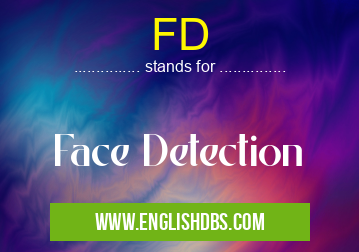What does FD mean in UNCLASSIFIED
FD stands for Face Detection. It is a technology that enables the detection of human faces in images and videos. FD is commonly used in various applications such as security surveillance, biometric identification, and entertainment.

FD meaning in Unclassified in Miscellaneous
FD mostly used in an acronym Unclassified in Category Miscellaneous that means Face Detection
Shorthand: FD,
Full Form: Face Detection
For more information of "Face Detection", see the section below.
How FD Works
FD algorithms typically involve the following steps:
- Image Preprocessing: The input image is processed to remove noise and enhance features.
- Feature Extraction: Key facial features such as eyes, nose, and mouth are extracted using techniques like Haar cascades or deep learning models.
- Face Detection: The extracted features are analyzed to determine if a face is present in the image.
Applications of FD
- Security and Surveillance: FD is used in security systems to detect and track individuals in real-time.
- Biometric Identification: FD plays a crucial role in biometric authentication systems by verifying a person's identity based on their facial features.
- Entertainment: FD is used in augmented reality and virtual reality applications to overlay digital content over the user's face.
- Image Editing: FD is incorporated into image editing software to automatically crop and enhance portraits.
Advantages of FD
- Non-Intrusive: FD is a non-contact method for detecting faces, making it user-friendly and non-invasive.
- Real-Time Processing: Modern FD algorithms can process images and videos in real-time, enabling rapid detection.
- Accuracy: Deep learning models used in FD have significantly improved accuracy, making it highly reliable.
Essential Questions and Answers on Face Detection in "MISCELLANEOUS»UNFILED"
What is Face Detection (FD)?
Face Detection is a technology used to locate and identify human faces in images or videos. It analyzes visual data to determine the presence, location, and facial features of individuals.
How does Face Detection work?
FD employs various techniques to identify faces, such as feature extraction, pattern recognition, and machine learning. It extracts facial features like eyes, nose, and mouth, and uses algorithms to match these features to known patterns, allowing it to identify faces with accuracy.
What are the applications of Face Detection?
FD has numerous applications, including:
- Security and surveillance
- Biometric identification
- Facial recognition systems
- Emotion analysis
- Healthcare and medical imaging
What are the challenges in Face Detection?
FD faces challenges such as:
- Variations in facial appearance due to age, expressions, and lighting
- Occlusions caused by facial hair, glasses, or hats
- Facial similarities between individuals
- Real-time processing requirements
How is Face Detection used in security and surveillance?
In security and surveillance, FD enables:
- Automated monitoring of crowds for suspicious activities
- Access control and identification systems
- Facial recognition for crime prevention and investigation
What are the ethical considerations with Face Detection?
Ethical considerations include:
- Privacy concerns and potential misuse of facial recognition data
- Bias and discrimination in facial recognition systems
- The importance of informed consent and transparency in the use of FD technology
Final Words: FD is a powerful technology that has revolutionized the way we detect and identify faces. Its applications range from security and surveillance to entertainment and image editing. With the continuous advancements in artificial intelligence and computer vision, FD is poised to play an increasingly vital role in our daily lives.
FD also stands for: |
|
| All stands for FD |
